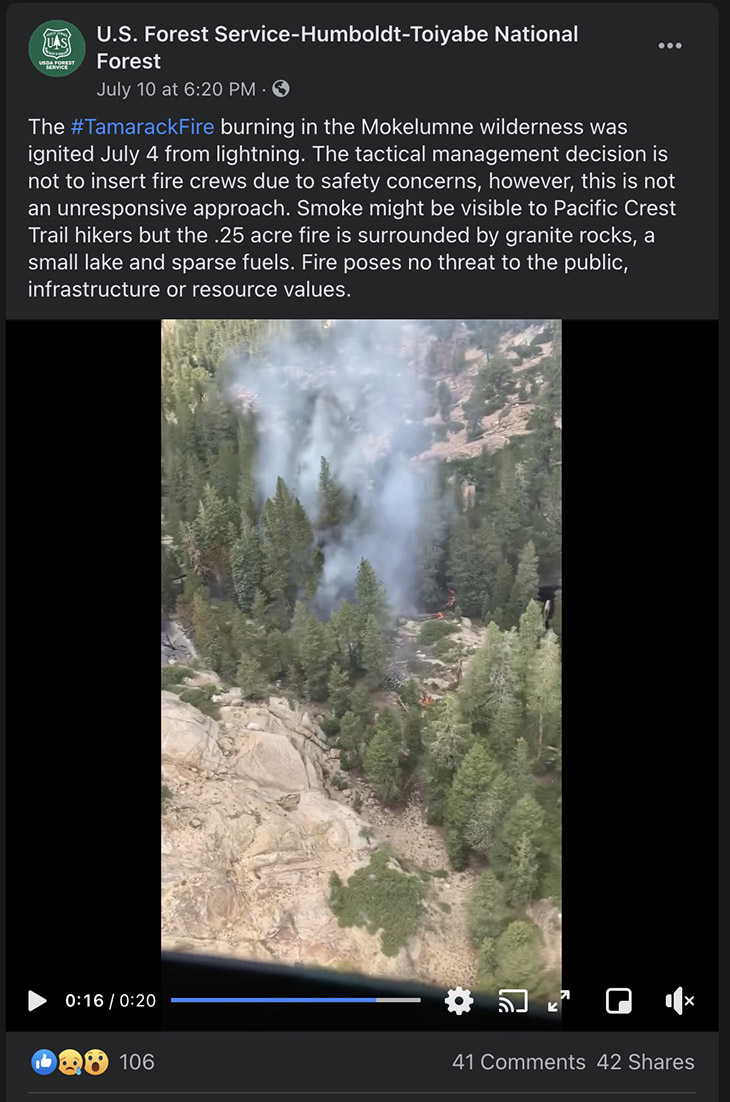“The Forest Service has no authority to let fires burn millions of acres — misappropriating tax dollars and recklessly destroying our natural resources. It’s an inverse condemnation of private property and wanton destruction of public resources, pure and simple.” ~ Frank Carroll
Agitator Frank Carroll, whom Dana Tibbitts with the Nevada Globe refers to as a “Chief Forester,” is an active part of this “discussion” in the Tahoe Basin and in New Mexico and other states, advising forest owners who hire him and assisting people in suing the Forest Service over losses resulting from escaped prescribed fires or managed fires that burned more acreage than Carroll thinks they should have. In her report, Tibbitts quotes anonymous sources to claim that FS Chief Randy Moore’s “Burn Back Better” letter (the annual fire-related “letter of intent”) has “caused a firestorm among firefighters and Forest Service veterans nationwide.”
Some of Tibbitts’ anonymous sources are associated with the “National Wildfire Institute,” founded by Bruce Courtright (retired FS Deputy Chief for Management Improvement) and Michael Rains — who at one time directed the USFS Forest Products Lab. Char Miller in the Los Angeles Times refers to the group as “a suppression-friendly bloc of retired Forest Service officials,” but they don’t seem to have a website or any publicly visible managers or founders besides Rains and Courtright.
Some other more widely respected retired fire experts disagree, and they’ve written here before on this topic, citing the founder of the U.S. Forest Service Gifford Pinchot. “The debate within the agency defies permanent resolution,” writes Char Miller,”not least because deference to political exigencies is baked into the Forest Service’s DNA. For that, we can thank, or blame, Pinchot.”
Miller is aIn an 1899 article in National Geographic,” he explains, “Pinchot clearly detailed wildfire’s essential role in regenerating forests in the South and mountainous West. But despite this robust ecological evidence, it would be fire’s bad optics that drove his pitch for establishing the Forest Service.” As per the agency’s first manual: “Probably the greatest single benefit derived by the community and the nation from forest reserves is insurance against destruction of property, timber resources, and water supply by fire.”
Opinion: The burning debate — manage forest fires or suppress them?
Carroll and his cohorts, though, claim that the USFS “just gave firefighters license to burn millions of acres of forest and rangelands with zero commitment to putting the fires out.”
Tahoe-Douglas Fire Chief and head of the Northern Nevada Fire Chiefs Association Scott Lindgren said, “The latest forecast and guidance from the Chief is so unhinged from firefighting realities on the ground as to defy rational analysis or practical guidance.”
“It’s caused a firestorm among firefighters and Forest Service veterans nationwide.” ~ Dana Tibbitts

According to Tibbitts and the Nevada Globe, USFS Regional Foresters are supposedly enacting a new policy now, calling for all fires in the Tahoe Basin to be risk-assessed and monitored by those same Regional Foresters, “who alone would determine the appropriate response to new fire ignitions.”
Chief Lindgren says allowing fires to burn is criminal and claims that allowing fires to burn means the USFS can count those acres as “treated” in burn quotas ordained by administrators in Washington DC. “These are not treated acres,” he says, “they are destroyed acres!”
Frank Carroll says USFS fire commanders and administrators are using firefighter safety as a false flag to justify wildfire use, even at the expense of civilian lives and devastated communities.
“Firefighter safety is an excuse that is neither safe nor supportable — a feature of the persistent failure to build informed consent and to analyze environmental impacts before letting wildfires burn and then expand them on purpose,” Carroll said. “They’re unilaterally implementing giant prescribed wildfires — consequences be damned.”
According to the anti-managed-fire crowd, the Biden-Harris administration’s plan to Burn Back Better is detailed in Confronting the Wildfire Crisis and lays out a 10-year program to treat 20 million acres of National Forest System lands and 30 million acres of other federal, state, tribal, and private lands. 
Randy Moore Letter of Intent 04/24/24 — click to read













